Me and my homeys got together last week for one more run at the US Amateur Team East:

The fellow in the Rocky Balboa hat is Ned Walthall. In the middle is Curt Kimbler, followed by Doug Proll on the end. How long have we been playing chess together? Well, let's just say that Ned used to give me rides to chess tournaments, back in the days before I was driving.
As big a chess fan as I am, I haven't been playing many tournaments over the last few years. Competing seriously means putting in some serious time and effort, and I just haven't felt too motivated in that direction lately. But the USATE is something special. Frankly, it's more of a social event than a chess tournament, at least for lower-rated teams like ours.
Let me remind you how this works. You play as part of a team of four. This means you play four individual games of chess, with no consultation among the players during the games. Your team gets one point for each win, half a point for each draw and zero points for a loss. After all four games are completed, the team with the most points wins the match. As far as the standings are concerned, all that matters are team points. It doesn't matter if your team wins 4-0 or 2.5-1.5,
We got paired down in the first round. Unluckily for me, though, it turned out to be one of those teams with a coach and three students. So while my teammates had the satisfaction of pounding on some kids (which, let me tell you, is very satisfying indeed), I got paired against an expert. Happily, he was having an off day! I had the white side of a Bishop's Opening. In the diagram, we're at move sixteen and it's black's turn.

I have just pushed my pawn to e5, in response to black's push of his pawn from d6 to d5. Had he replied with the cautious 16. ... Nd7, then white could claim a small edge but nothing more.
Instead he went for glory with 16. ... d4? After 17. exf6 dxe3
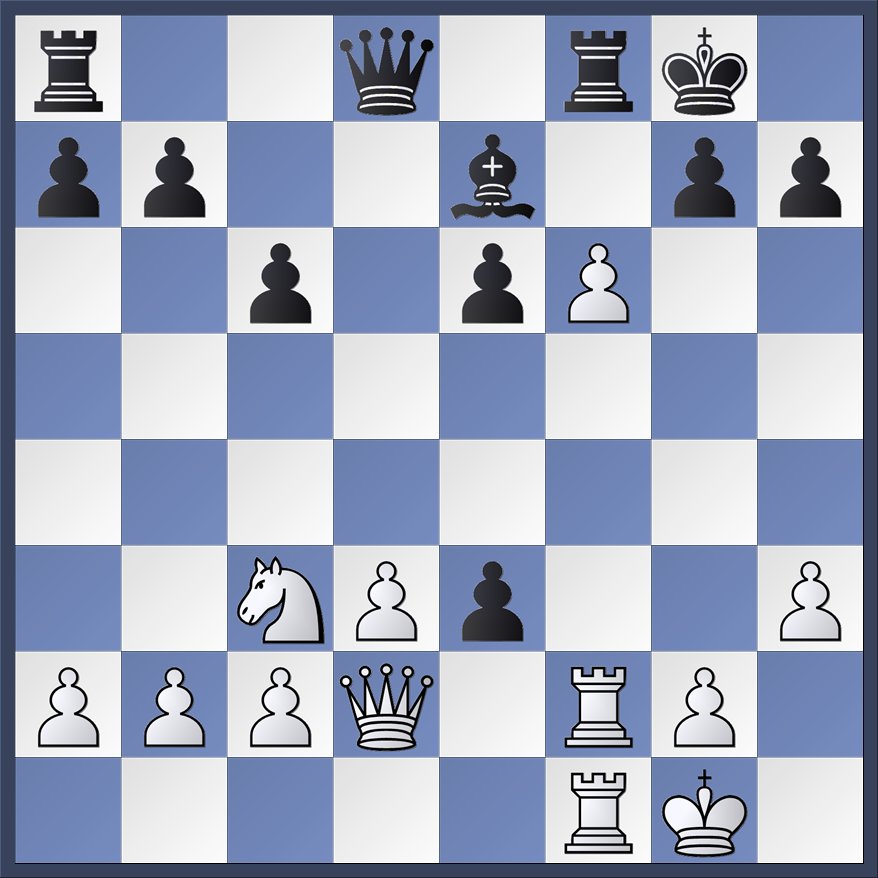
he saw that I couldn't take the bishop on e7, because then he would take my rook on f2 with check. Alas, he forgot that I could play the simple 18. Qxe3 Bxf6 19. Qxe6+ and suddenly I'm just up a pawn. Moreover, my pieces are far more active than his, since my rooks are doubled and my knight is about to become a ferocious beast on e4.
Fast-forwarding a bit, we come to this:
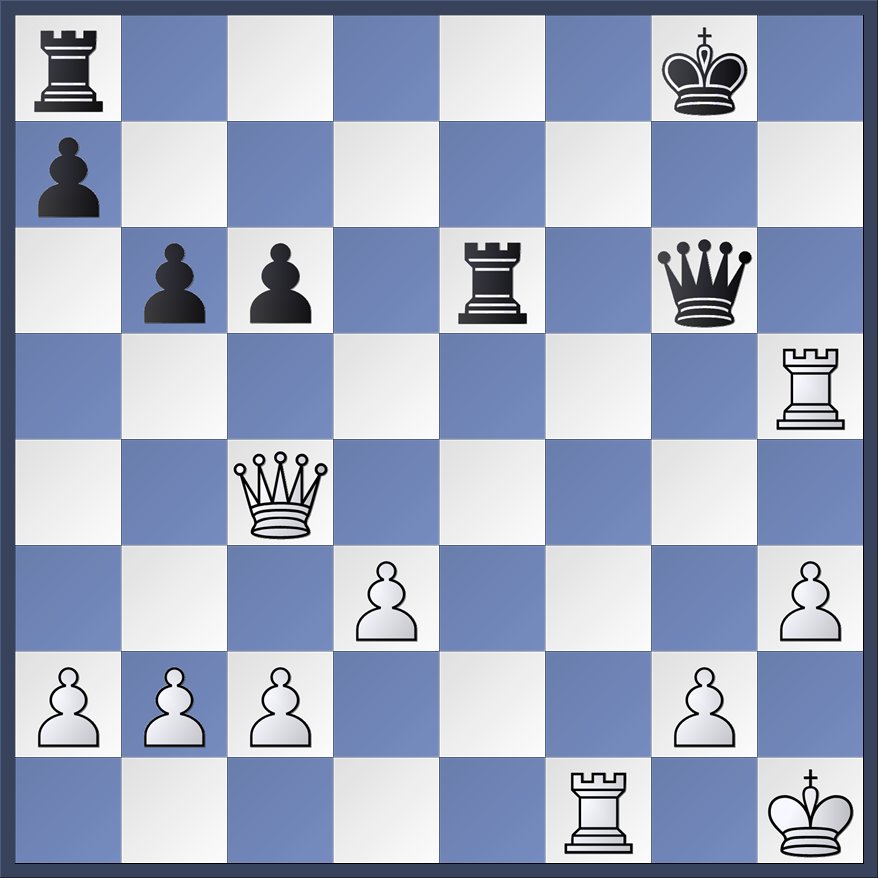
My queen and marauding rooks had been probing for a while now, and while I had managed to gobble up two more pawns he had so far managed to avoid either mate or catastrophic material loss. He has just blocked the check from my queen by placing his rook on e6. At this point the computer points out that 34. Rff5 would immediately make black go splat. But I couldn't resist playing 34. Re5, emphasizing the fact that black's rook is pinned. After the forced sequence 34. ... Rae8 35. Rfe1 Kf7 36. Rxe6, black resigned. All of the queens and rooks will come off the board, and white will win trivially with his three extra pawns.
Our reward for taking care of business in the first round was to get paired way up in the second. On paper we were in trouble, since we were giving up several hundred rating points on each board. But ratings aren't everything. On Board Two, Doug opened up a big can of whoop-ass on his unsuspecting opponent:
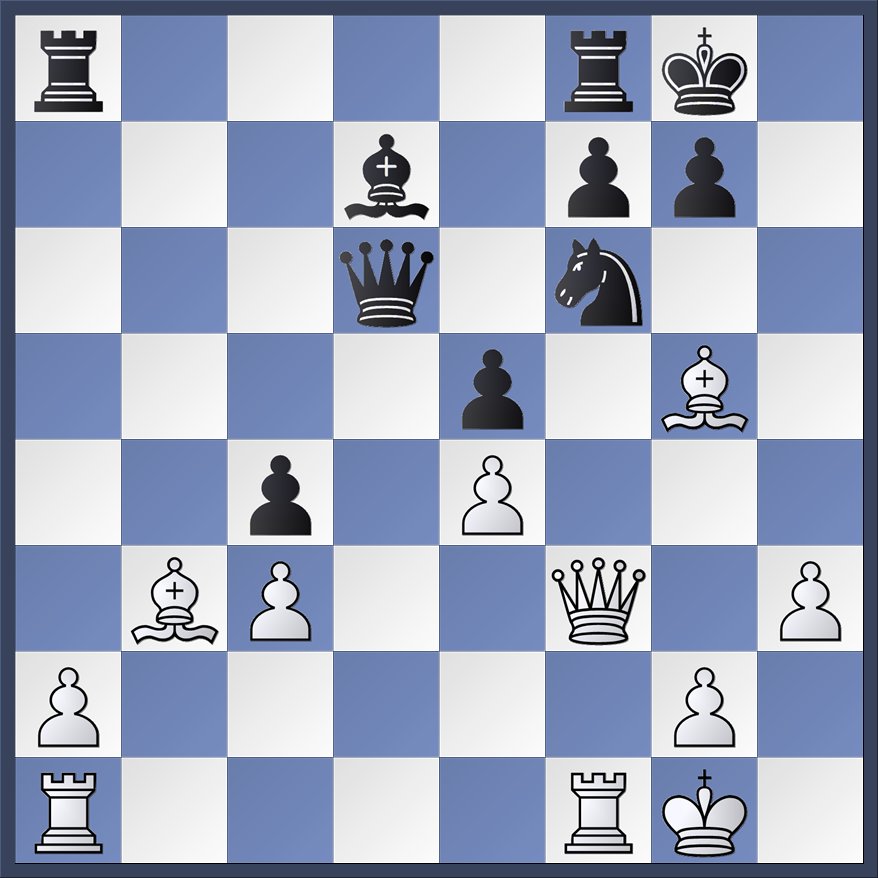
Earlier in the game, Doug's opponent had rather carelessly blundered a pawn. But he probably wasn't too worried at this point. He's just pushed his pawn to c4, and figured that after some meek bishop retreat on white's part he would be able to generate counterplay against white's weak queenside. Doug scuppered that plan with the direct 24. Bxc4! His opponent thought he was getting a free piece with 24. ... Qc5+ 25. Kh2 Qxc4, but then came 26. Bxf6 gxf6 27. Qg3+ Kh7 28. Qh4+ Kg8 29. Rf3 Rfc8:
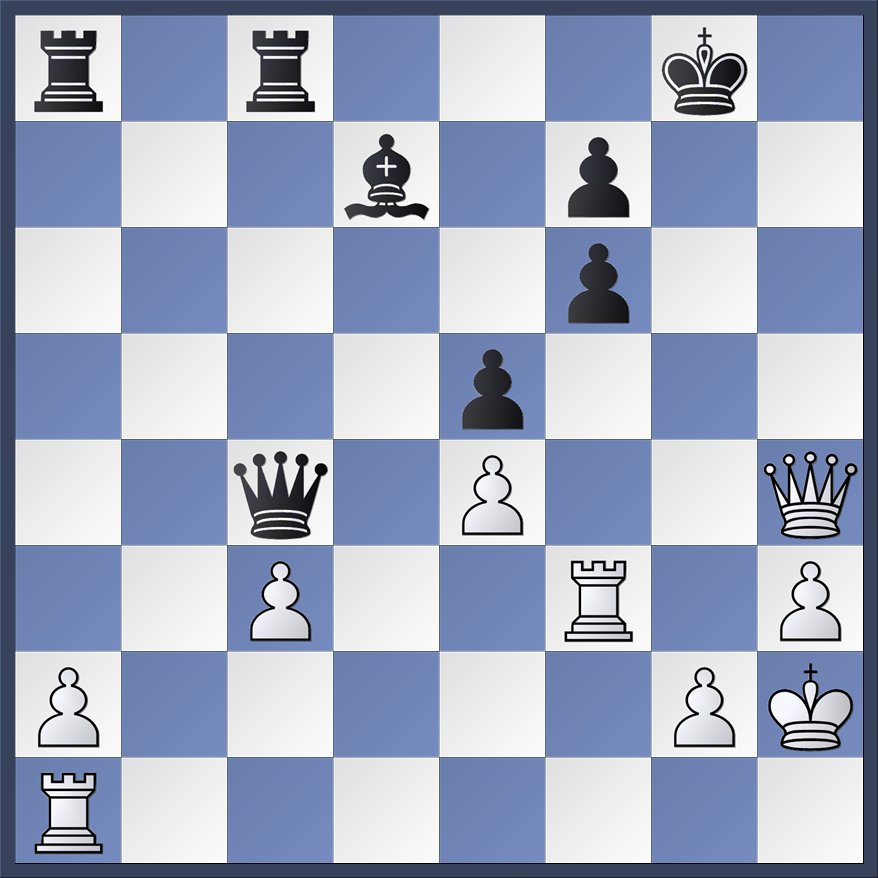
Black's last move was intended to create luft for the king, but after 30. Qh6 black's king is going nowhere. After a few more moves black was forced to resign.
Meanwhile, Ned managed an effortless draw on board four. Curt, alas, went down on board three, meaning that everything came down to my game on board one.
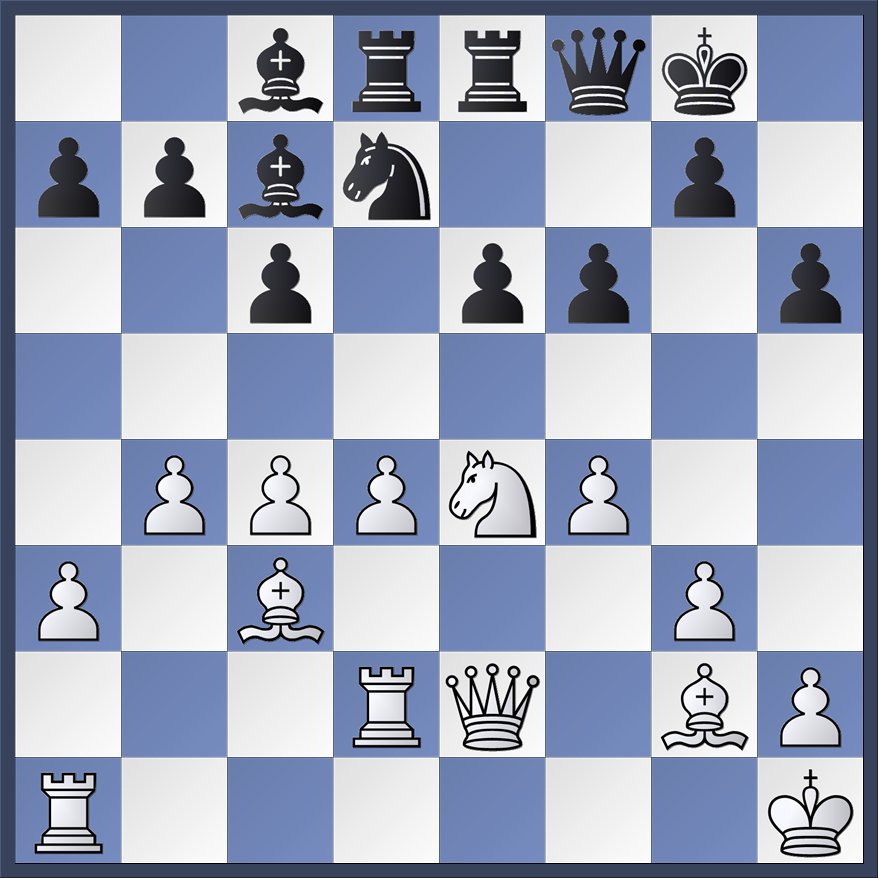
This came out of a Catalan Opening. I was playing black and was about to make my 24th move. The position is interesting. White can certainly claim a clear advantage based on his extra space, but black's pieces are not so badly placed. If white is not careful about choosing the correct pawn break, black's pieces could easily spring to life.
The computer recommends that black should continue to wait with 24. ... Qf7 or 24. ... Nb6, but I got impatient with 24. ... e5. Figured I would get my pawn break in before he played one of his. Things suddenly got chaotic. Play continued: 25. fxe5 fxe5 26. d5 cxd5 27. cxd5 Nf6. Several moves later, however, the smoke had cleared somewhat and we had arrived at this complicated position:
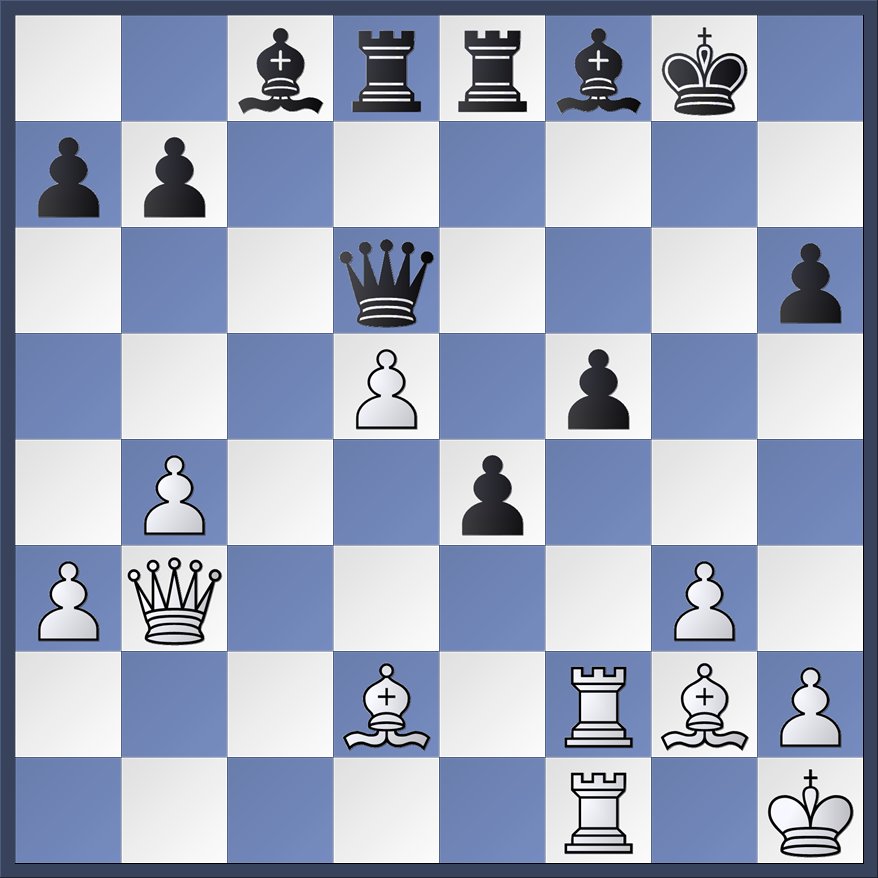
It seems like white might be in some trouble now. His d-pawn is about to fall and his once formidable bishop on g2 has been completely blunted. White realized he needed something dramatic here, and very sensibly went for the exchange sac with 38. Rxf5 Bxf5 39. Rxf5. This is where things got interesting. I had a little over two minutes left to make my fortieth move, and my opponent had only slightly more. I had anticipated white's sac several moves earlier, and thought I had the refutation. I banged out 39. ... Re5. The main point was that the seemingly strong 40. Bf4 fails to 40. ... Qxd5.
But my move is a mistake nevertheless. Had white replied with 40. Rxe5 Qxe5 41. d6+ Kh7 42. Bc3 he would have been firmly in the driver's seat once more, since his position is suddenly very active and black's king is definitely feeling the breeze. But in time pressure of his own white instead played 40. Bh3. The point was that after something like 40. ...Rxd5 41. Rxd5 Qxd5, white has the surprising 42. Be6+. I had completely missed this resource back when I had pondered this position several moves earlier. On the outside I was careful to maintain my best poker face, but on the inside it was all profanity and self-flagellation.
Actually, though, white's move is not good. With the simple 40. ... Qxd5 41. Qxd5 Rdxd5! black should have a winning position, though there is certainly more work to do. Instead, with my last few seconds ticking away, I played 40. ... Rxf5, but after 41. Bxf5 Bg7 42. Bxe4 white once more had the upper hand.
It was well past midnight at this point. My teammates abandoned me to go to sleep, figuring they could wait until morning to find out how things turned out. Having made time control, my opponent and I both went in for big thinks. Black has to be very careful since White's bishops are active and the d-pawn is a monster, but I wasn't panicking. Black can get his queen active and trade off the dark squared bishops. Considering that white's king position is also a bit breezy I felt I had good chances to hold the draw. Play continued 42. ... Qf6 43. Bf4 Qd4 44. d6+ Kh8 bringing us to this position:
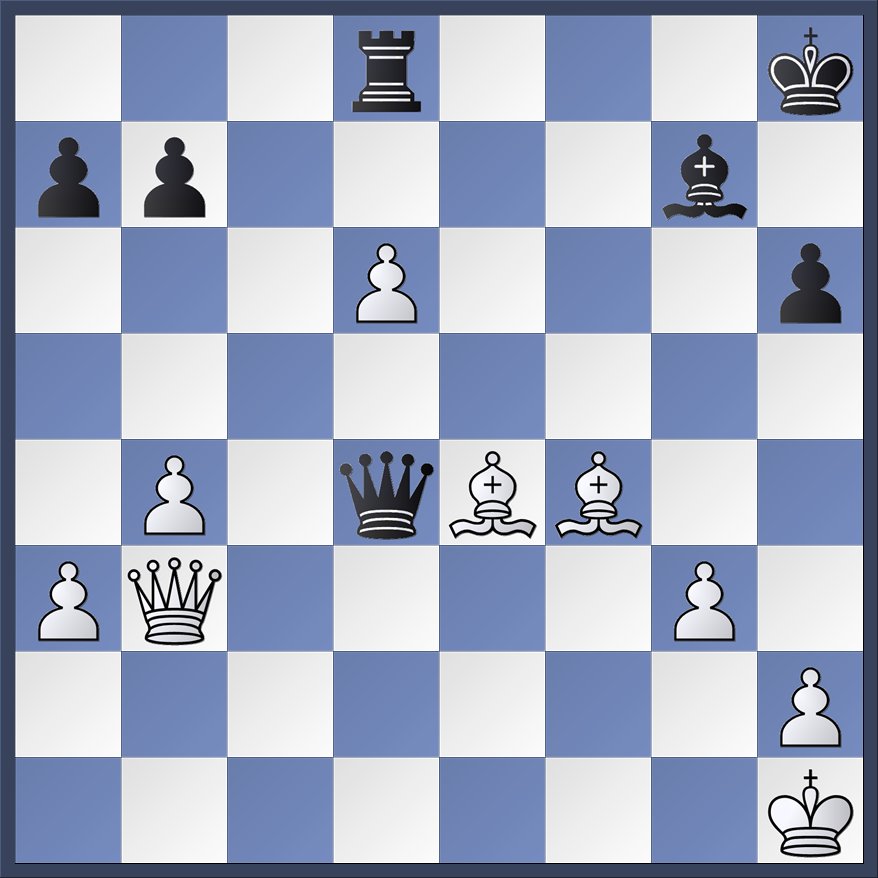
White now played the seemingly active 45. Qe6. Indeed, this would be crushing but for the fact that black how has a perpetual check with 45. ... Qd1+ 46. Kg2 Qe2+ 47. Kh3 Qh5+ 48. Kg2 Qe2+. So after all that hard work the game ended in a draw, almost exactly five hours after it started. Fun!
So the match ended in a tie, meaning we were now at 1.5/2. Our reward for overachieving in such a manner was to get paired way up in the next round. I was playing a 2300+ rated master. We plowed down one of the main lines of the Dragon Sicilian until we reached this position:
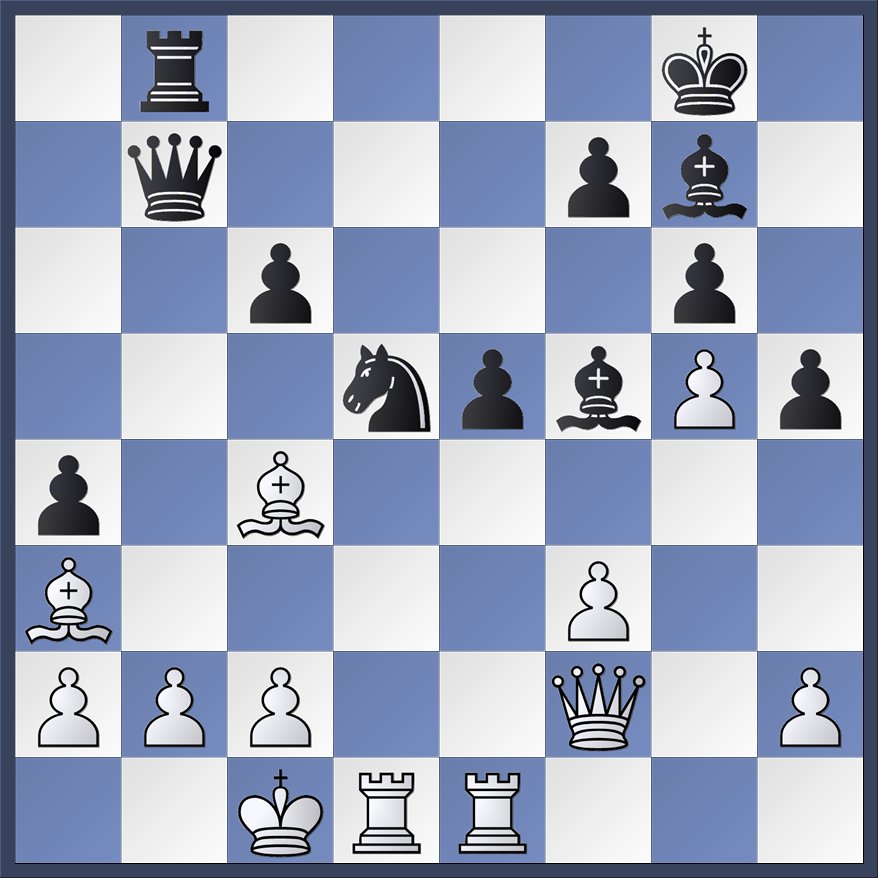
At the board I thought I was doing rather well, having won an exchange. Of course, in the Dragon it is often white's undoing to win an exchange, but in this case I thought my material gain had come under auspicious circumstances, since I had maintained my bishop pair. The computer, though, is not so impressed with white's position.
Regardless, in the above position I played 26. Bd3. This is a blunder. Better was 26. b3, but even here black would have a lot of play for the exchange, starting with 26. ... Nc3. Alas, after my move there followed: 26. ... e4 27. fxe4 Bxb2+ 28. Bxb2 Qxb2+ 29. Kd2 Qb4+ Here I was thinking that the game would end in perpetual check after 30. Kc1. Sadly, I completely missed that 30. ... Nc3 threatens the game-ending Nxa2 mate. Ouch! Cue the mental profanity. I resigned a few moves later.
As it happens, though, Ned pulled off the upset on board four and Curt held a draw on board three. Doug went down on board two. So we lost the match, but by the smallest possible margin.
But we came crashing down to Earth in the next round. Once again we were giving up a whole bunch of rating points on every board. The most interesting part of my game was the opening, since my opponent, an expert, as white, unleashed the Pseudo-Trompowsky Attack. The game opened with the somewhat outre 1. d4 d5 2. Bg5. Things settled down quickly into a fairly standard sort of double-queen pawn structure. The game ended in an uneventful draw, though the final position makes for an amusing diagram:

White has been pushing all his pawns looking for a break, but right around here it dawned on him that his b and d pawns are quite weak, and that black's pieces are actually pretty well placed. On the other hand, black can't really do much either. The computer confirms that the position is dead level, and since the team match was over at this point (my homeys got skunked), my opponent and I decided just to call it a night.
Happily, my good friend Jon Edwards was on hand, playing on a different team, to contribute some excitement. Jon is a former United States Correspondence Chess Champion and is the author of numerous chess books, all of them excellent. Here's the position, with Jon, playing black, about to make his 23rd move.
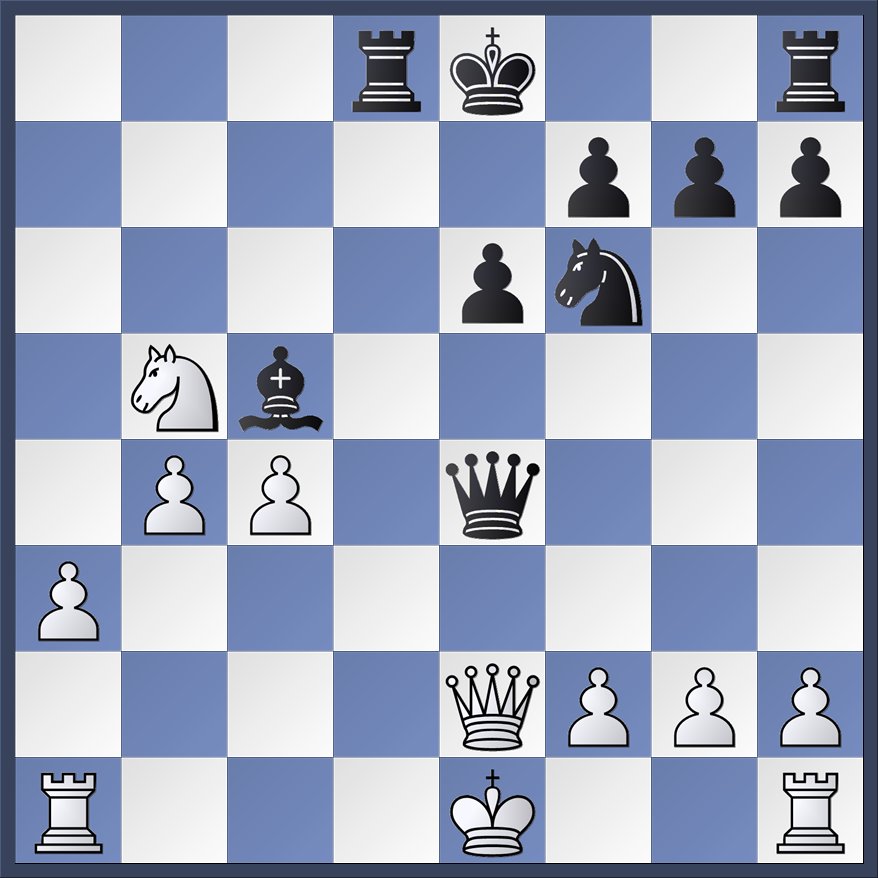
The computer now gives 23. ... Qxg2 as the cleanest kill, but Jon decided to go for glory with the delightful 23. ... Bxf2+! White must accept the sacrifice, since 24. Kf1 Be3 would be hopeless. Play continued 24. Kxf2 Ng4+ 25. Ke1 Ne3 26. Rc1 Nxg2+ 27. Kf2 Qf4+ 28. Kxg2 Rd2 29. Nc7+ Kd7 30. Rbd1, bringing about this position:
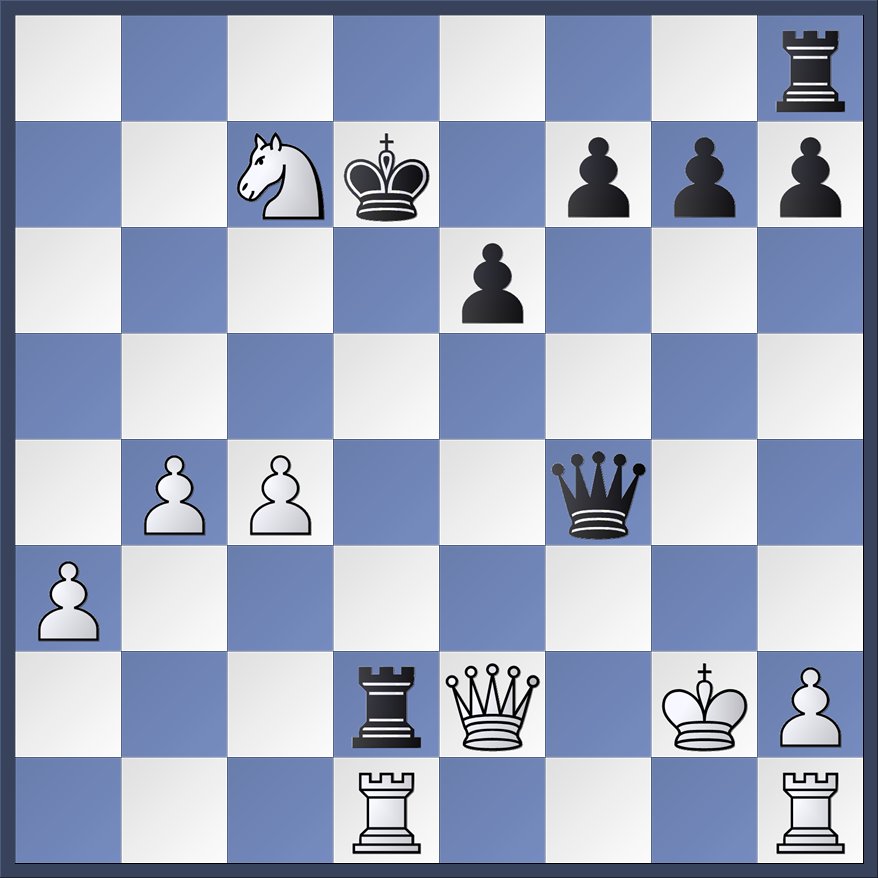
At first glance it might seem that black has overplayed his hand, since his rook on d2 is now pinned to the king. But Jon had foreseen this possibility and played 30. ... Qe4+. His opponent immediately resigned, since he is about to lose his queen. The computer, though, churlishly points out that 30. Qg4+ is even stronger, since it quickly leads to mate.
Having crapped out in the previous two rounds, we were finally paired down in round five. My opponent, who I don't think was over twelve, informed me that we had actually played in the first round of this tournament two years earlier. I didn't remember the game, but after getting home I managed to track down the old scoresheet. I won. Woo Hoo!
He was rated in the 1700s. This time I had the white side of a Najdorf Sicilian. I replied with the English Attack. He played one of those lines with an early h5 for black, which blunts white's kingside attack at the cost of weakening the kingside and delaying development. I played a quiet line where I castled on the kingside, and twelve moves in we reached this position:

Here my opponent decided to break with 12. ... d5. This is black's thematic break in many lines of the Sicilian, but it is risky to play it when black's king is still in the center. After 13. Nxd5 Nbxd5 14. exd5 Nxd5 we come to this:

I was rather proud of myself for finding 15. Bc4. With proper defense by black it should only give white a small edge, but it clearly caught my opponent by surprise. The main point is that after 15. ... Nxe3 16. Qxe3, black does not have time to take advantage of white's unprotected bishop on c4, since white's rook is now attacking black's queen. So play continued 16. ... Qc8 17. Bxe6 Qxe6
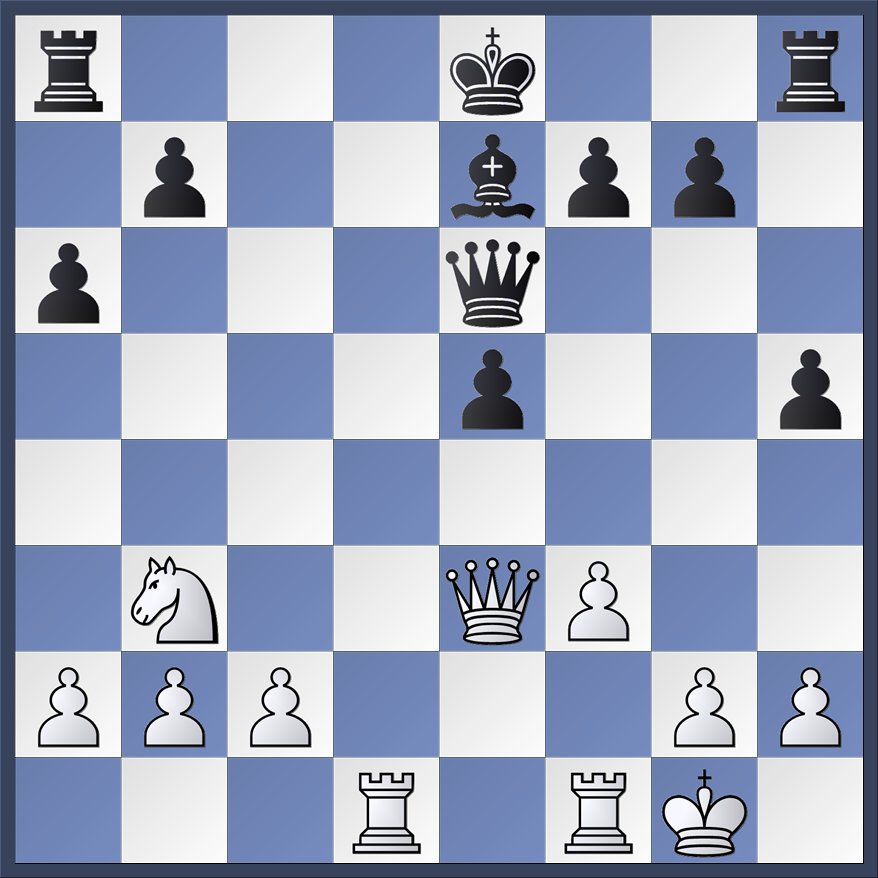
And now we see that black has problems. His e-pawn and b-pawn are weak, and his king is still stuck in the center. White's rooks have open files, his f-pawn makes an effective battering ram, and his knight will join the attack via d4 or c5. With nerves of steel and perfect defense black can probably hold the balance, but white is definitely having more fun.
Play continued 18. Qe4 Qb6+ 19. Kh1 Qc7 20. Rd5 Bd6 21. f4 f6 22. Qg6+ Kf8 23. fxe5 Bxe5 24. Nc5 Qe7:
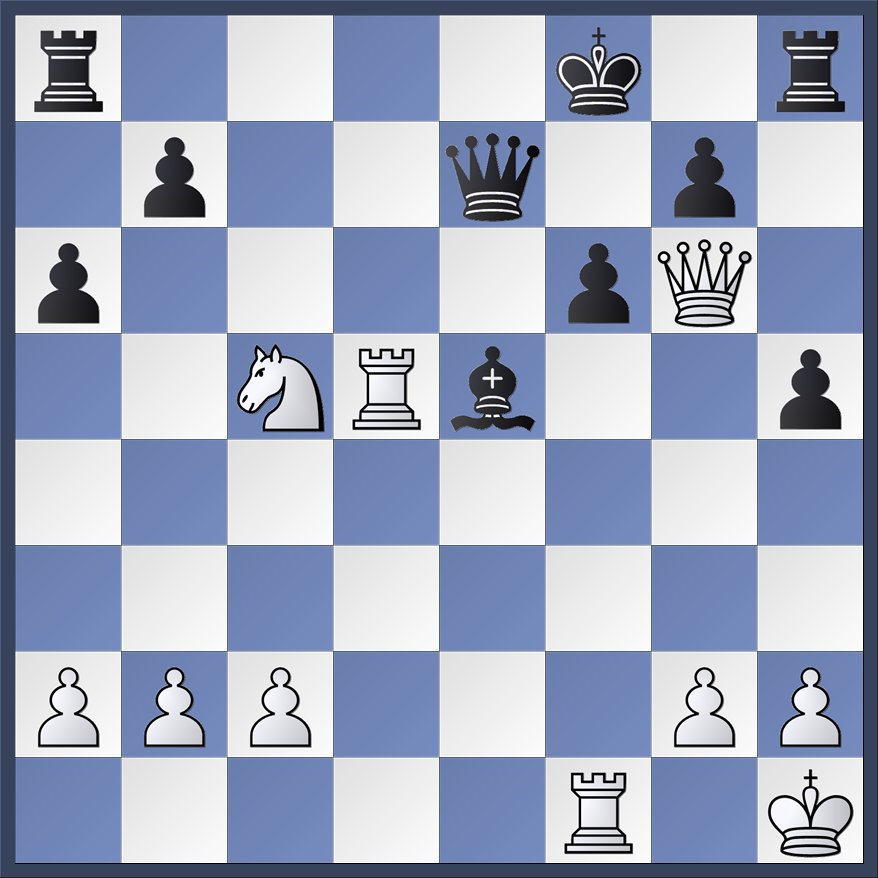
And now 25. Rd7 would certainly get the job done, but I played the flashier 25. Rxe5. Black can't take with the pawn because it is pinned, and 25. ... Qxe5 loses to the fork 26. Nd7+. So black is just down a piece. After 25. ... Rh6, I decided the simplest kill was just to trade queens with 26. Rxe7 Rxg6 27. Rxb7 and black resigned a few moves later.
The rest of the gang took care of business also, and we got paired up again in the last round. Ned pulled off an easy win on board four. Alas, I continued my tradition of last round faceplants at the USATE. My opponent met by double queen pawn opening with the Blackmar-Diemer Gambit. The grandmasterly consensus is that this opening is simply unsound, but that's not very helpful when you have to face it at the board. Suffice it to say that my approach will not be showing up in any books as the gambit's refutation. I blundered right out of the opening, and while I struggled on for a while to make it respectable, the writing was on the wall by move ten. Oh well.
So that was that. Having finished our games relatively quickly, Ned and I decided to hightail it out of there. Doug, Curt, if you're reading this, how did your last round games go? Anyway, the tournament was a blast. I'm already looking forward to doing it again next year!

Hm...looks like it might be even harder than Sudoku, though at least it's easier to spell. No wonder I never took up chess.
Wonderful read, Jason! Always fun to scope out the tactical shots.... In your Dragon game I'd've played the cringing 26 Re4 returning the exchange but I'm basing this on about 20 seconds' worth of rather rusty thought. I think White's worse anyway, but any time White can keep the Dragon bishop blocked in for a few moves it quiets the stomach quite a bit.
Looks like your teammates may've picked up a few rating points? How close to the ropes did you guys get?
Hi Bill! How nice to hear from you.
In the Dragon game, Re4 might have been a decent defensive try. But to be honest, I wasn't thinking, “I should look for a way to give back the exchange to blunt his formidable counterplay.” I was thinking, “Woo hoo! I'm up an exchange against a master!”
Since we were 1.5 out of 2 at that point, we got very close indeed to the ropes. As I said, thanks to Curt and Ned we made quite a decent showing for ourselves in that round, but it wasn't quite enough.
So what do you think? Can we lure you out of retirement next year?
Gotta love McNeal!
Jon, Derrick, Joel & I (well Derrick and I) did not fair well but had a blast! If you cann't manage to play, you should stop by and say hello. We would all love to see you. Cige made an appearance and I harrass Hersberg every year.
Bill,
What a treat to hear from you. We had a great time, but we always do at this tournament. One of my best tournaments in years, actually. I beat a couple players over 1800. We actually got as high as board 24, I think, and if Jason could have pulled out a win against his 2300 rated opponent, rather a lot to ask actually, things could have gotten a little hairy in the next round. :-)
Wonderful to hear from you. Hope you are well.
Best,
Ned
Another good summary article of USate Jason! I'd be curious to hear your thoughts on the USCF rating system. With your mathematics background, I'm guessing you have some opinions.
Hi Brian. I'm glad you liked the post. To be honest, I don't really have a strong opinion one way or the other about the rating system. I mostly just let my rating take care of itself and don't think about it too much.
Did you have a good tournament this year?
That is the correct attitude Jason. I had a good tournament. I beat a master, drew a master, beat an expert, and a 1700 but drew two 1800s. Enough for 13 points.